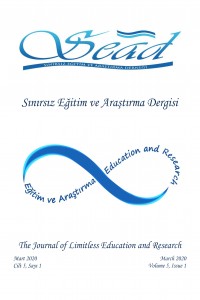Abstract
Günümüzde oyunla öğrenme yaklaşımı açısından tekerlemelerin önemli bir yeri vardır. Tekerleme masal, hikâye, halk tiyatrosu gibi edebi ürünlerde, çocuk oyunları ve günlük yaşamda kullanılan kafiyeli ve ritmik sözlerdir. Masalların giriş kısımlarında dinleyicilerin dikkatini çekmek, çocuk oyunlarında ise ebe veya grup liderini seçmek için söylenmektedir. Masal, oyun (çocuk) ve zor söylenen tekerleme gibi türlere ayrılmaktadır. Bunların içinde en zengini çocuk tekerlemeleridir. Çocuk tekerlemelerinin uzun ve zengin bir geçmişi vardır. Eskiden çocuk tekerlemeleri denilince daha çok oyun aracı akla geliyordu. Günümüzde bu anlayış değişmiş, çocuk tekerlemelerinin eğitici yönü öne çıkmıştır. Çoğu ülkede çocukların dil, zihinsel, sosyal ve fiziksel becerilerini geliştirmek amacıyla kullanılmaktadır. Okul öncesi ve ilkokul programları ile ders kitaplarında çeşitli tekerlemelere yer verilmektedir. Araştırmalarda tekerlemelerin çocukları sosyalleştirme, güven verme ve güdüleme rollerine vurgu yapılmaktadır. Ayrıca çocukların dil, zihinsel, sosyal ve fiziksel becerileri geliştirmeye yararları dile getirilmektedir. Eğitim sürecinde ise tekerlemelerle çocukların iyi okuyucu olma, kendilerini geliştirme, yaşam boyu öğrenme ve geleceğe yön vermeleri üzerinde durulmaktadır. Bu amaçla ders kitaplarındaki tekerlemeler özenle seçilmektedir.
Keywords
References
- Arfa, M. (2008). La lecture à haute voix, Ministère de l’éducation et de la formation,Direction régionale de Bizerte.
- Bustarret, AH. (1975). L’enfant et les moyens d’expression sonore. Paris: Les Éditions Ouvrières.
- Bustarret, AH.(1982). L’oreille tendre, pour une première éducation auditive. Paris: Les Éditions Ouvrières.
- Cuq, J.P .(2003). Dictionnaire de didactique du français :Langue étrangère et seconde,Paris :Clé international.
- Chahinez,D.(2015). Place de comptine dans le manuel scolaire et l’apport de cette dernière a l’apprentissage / enseignement du FLE cas de classe de 4ème AP, (diplôme de Master), Université Abou Bakr Belkaid Tlemcen. Algerie.
- Danielson E.(2000). The Importance of Nursery Rhymes,02.02.2020 tarihinde http://www.eric.ed.gov/contentdelivery/servlet/ERICServlet?accno=ED442117. adresinden erişilmiştir.
- Galisson,R et Coste,D.(1976).Dictionnaire de didactique des langues ,Paris : Edition Hachette.
- Gagnard M.(1977). L’éveil musical de l’enfant. Paris: ESF.
- Grandcoin-Joly,G. (2008 ).Pour une classe réussie en maternelle,Paris: Edition Nathan
- Gauthier, J-M.,Lejeune,C.(2008).Les comptines et leur utilité dans le développement de l’enfant, Neuropsychiatrie de l’enfance et de l’adolescence, 56 (2008),s. 413–421.
- Güneş,F.(2019).İlkokuma yazma öğretimi yaklaşım ve modeller,Ankara:Pegem A Yayınları
- Güneş, F. (2015). “Oyunla Öğrenme Yaklaşımı / Game-Based Learning Approach”, Turkısh Studies - International Periodical for the Languages, Literature and History of Turkish or Turkic-,1308- 2140, 10(11),s. 773-786. Doı Number: http://dx.doi.org/10.7827
- Kempemeers, V.(2005). La comptine et son utilisation en classe de maternelle. Mémoire de licence en psychologie non-publié, université de Liège, Liège, Belgique.
- Lescout, M. (1985). Autour des comptines. Paris: Edition Nathan.
- Ros-Dupont, A. Billaud-Lecoinet, A.-M. Ducros, I. Dupinay-Lemaire.(1999) La lecture à haute voix du CP au CM2, BORDAS
- Tremouroux-Kolp O.(1997). Le chemin des comptines. Bruxelles: Labor.
Abstract
Today,rhymes have an important place in terms of game learning approach. Rhymes are rhythmic and rhythmic words used in literary products such as fairy tales, stories, folk theater, children's games and daily life. It is said to attract the attention of the audience at the entrance of the fairy tales and to choose the midwife or group leader in the children's games. The fairy tale is divided into types such as play (child) and hard-to-say rhyme. The richest child rhymes are among them. Child rhymes have a long and rich history. When we talked about nursery rhymes in the past, more game tools came to mind. Today, this understanding has changed and the educational aspect of child rhymes has come to the fore. It is used in most countries to improve children's language, mental, social and physical skills. There are various rhymes in preschool and primary school programs and textbooks. Research emphasizes the role of rhymes in socializing, reassuring and motivating children. In addition, the benefits of children to develop language, mental, social and physical skills are expressed. In the education process, it is emphasized that nursery rhymes, children become good readers, develop themselves, lifelong learning and shape the future. For this purpose, rhymes in textbooks are carefully selected.
Keywords
References
- Arfa, M. (2008). La lecture à haute voix, Ministère de l’éducation et de la formation,Direction régionale de Bizerte.
- Bustarret, AH. (1975). L’enfant et les moyens d’expression sonore. Paris: Les Éditions Ouvrières.
- Bustarret, AH.(1982). L’oreille tendre, pour une première éducation auditive. Paris: Les Éditions Ouvrières.
- Cuq, J.P .(2003). Dictionnaire de didactique du français :Langue étrangère et seconde,Paris :Clé international.
- Chahinez,D.(2015). Place de comptine dans le manuel scolaire et l’apport de cette dernière a l’apprentissage / enseignement du FLE cas de classe de 4ème AP, (diplôme de Master), Université Abou Bakr Belkaid Tlemcen. Algerie.
- Danielson E.(2000). The Importance of Nursery Rhymes,02.02.2020 tarihinde http://www.eric.ed.gov/contentdelivery/servlet/ERICServlet?accno=ED442117. adresinden erişilmiştir.
- Galisson,R et Coste,D.(1976).Dictionnaire de didactique des langues ,Paris : Edition Hachette.
- Gagnard M.(1977). L’éveil musical de l’enfant. Paris: ESF.
- Grandcoin-Joly,G. (2008 ).Pour une classe réussie en maternelle,Paris: Edition Nathan
- Gauthier, J-M.,Lejeune,C.(2008).Les comptines et leur utilité dans le développement de l’enfant, Neuropsychiatrie de l’enfance et de l’adolescence, 56 (2008),s. 413–421.
- Güneş,F.(2019).İlkokuma yazma öğretimi yaklaşım ve modeller,Ankara:Pegem A Yayınları
- Güneş, F. (2015). “Oyunla Öğrenme Yaklaşımı / Game-Based Learning Approach”, Turkısh Studies - International Periodical for the Languages, Literature and History of Turkish or Turkic-,1308- 2140, 10(11),s. 773-786. Doı Number: http://dx.doi.org/10.7827
- Kempemeers, V.(2005). La comptine et son utilisation en classe de maternelle. Mémoire de licence en psychologie non-publié, université de Liège, Liège, Belgique.
- Lescout, M. (1985). Autour des comptines. Paris: Edition Nathan.
- Ros-Dupont, A. Billaud-Lecoinet, A.-M. Ducros, I. Dupinay-Lemaire.(1999) La lecture à haute voix du CP au CM2, BORDAS
- Tremouroux-Kolp O.(1997). Le chemin des comptines. Bruxelles: Labor.
Details
| Primary Language | Turkish |
|---|---|
| Subjects | Studies on Education |
| Journal Section | Makaleler |
| Authors | |
| Publication Date | March 15, 2020 |
| Submission Date | February 6, 2020 |
| Acceptance Date | March 13, 2020 |
| Published in Issue | Year 2020 Volume: 5 Issue: 1 |


